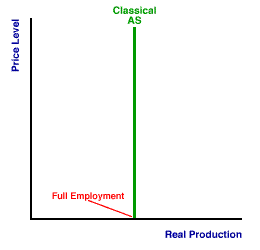
|
|
BARTER: A method of trading goods, commodities, or services, directly for one another without the use of money. In a barter exchange one good is traded directly for another. This sort of exchange ultimately requires a double coincidence of wants, meaning that each trader has what the other trader wants and wants what the other has. Without a double coincidence of wants the exchange process can become exceedingly complex, requiring a great deal of resources to complete transactions, resources that can not be used for production. In fact, inefficient barter trading was the primary reason that money was invented. With money, more resources can be used for production and fewer are needed for trading.
Visit the GLOSS*arama
|
|


|

|
                           CLASSICAL AGGREGATE SUPPLY CURVE: An aggregate supply curve--a graphical representation of the relation between real production and the price level--that reflects the basic principles of classical economics. The classical aggregate supply curve is vertical at the full-employment level of real production indicating that the quantity of aggregate production is independent of the price level. An alternative is the Keynesian aggregate supply curve. An aggregate supply curve is a graphical representation of the relation between real production and the price level. Classical economics implies that the full-employment level of real production is maintained regardless of the price level, which creates a vertical, or perfectly elastic, aggregate supply curve. This relation results due to flexible prices, which ensure that resources markets maintain equilibrium balance at full employment. Should the price level rise or fall, wages and resource prices adjust to ensure that quantity demanded equals quantity supplied in resource markets.| Classical AS Curve |  |
The exhibit to the right illustrates a classical aggregate supply (AS) curve. The obvious characteristic is that the curve is actually a vertical line. The line is vertical at the full-employment level of real production. Should the price level rise or fall, the economy moves up and down along the curve and real production remains unchanged.The full-employment level of real production corresponds to the natural unemployment rate, also termed the non-accelerating inflation unemployment rate. The measured unemployment rate is not necessarily zero. This rate includes both frictional unemployment and structural unemployment and results if the quantity of labor demanded is equal to the quantity of labor supplied. The classical aggregate supply curve looks a great deal like the long-run aggregate supply curve. Both are vertical at the full-employment level of real production. Both indicate that real production is unaffected by changes in the price level. The reason for the similarity is that the long-run aggregate supply curve is the modern embodiment of the principles of classical economics. For the classical aggregate supply curve, changes in the price level results in changes in wages and resource prices that ensure equality between quantity demanded equals quantity supplied in resource markets. For the long-run aggregate supply curve, changes in the price level results in changes in wages and resource prices that ensure equality between quantity demanded equals quantity supplied in resource markets--in the long run.

Recommended Citation:CLASSICAL AGGREGATE SUPPLY CURVE, AmosWEB Encyclonomic WEB*pedia, http://www.AmosWEB.com, AmosWEB LLC, 2000-2024. [Accessed: May 2, 2024].
Check Out These Related Terms... | | | | | | |
Or For A Little Background... | | | | | | | | | | | | | | | |
And For Further Study... | | | | | |
Search Again?
Back to the WEB*pedia
|



|

|
GREEN LOGIGUIN
[What's This?]
Today, you are likely to spend a great deal of time watching the shopping channel trying to buy either a T-shirt commemorating last Friday (you know why) or a rotisserie oven that can also toast bread. Be on the lookout for florescent light bulbs that hum folk songs from the sixties.
Your Complete Scope
This isn't me! What am I?
|

|
|
The first paper notes printed in the United States were in denominations of 1 cent, 5 cents, 25 cents, and 50 cents.
|

|
|
"Leadership is based on inspiration, not domination; on cooperation, not intimidation. " -- William A. Ward
|

|
AACCLA
Association of American Chambers of Commerce in Latin America
|

|
|
Tell us what you think about AmosWEB. Like what you see? Have suggestions for improvements? Let us know. Click the User Feedback link.
User Feedback
|


|


